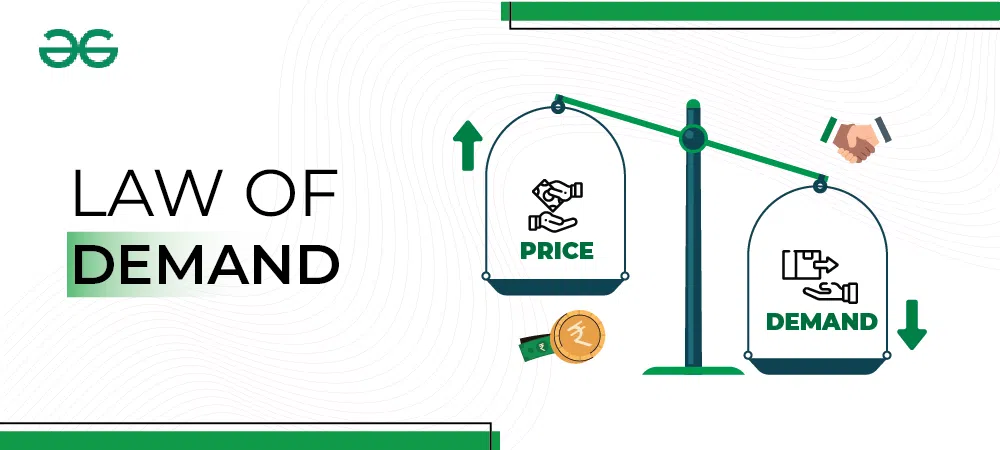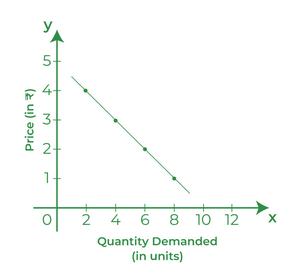What is the Law of Demand?
The Law of Demand states that there is an inverse relationship between the price and quantity demanded of a commodity, keeping other factors constant or ceteris paribus. It is also known as the First Law of Purchase. There are several other factors besides the price of the given commodity that affect the quantity demanded of a commodity. Therefore, in order to understand the separate influence of one factor affecting the demand, it is essential that the other factors are kept constant. Hence, under the Law of Demand, it is assumed that other factors are constant.

Assumptions of Law of Demand
The assumptions on which the Law of Demand is based are as follows:
1. The price of substitute goods does not change.
2. The price of complementary goods also remains constant.
3. The income of the consumer does not change.
4. Tastes and preferences of the consumers remain the same.
5. People do not expect the future price of the commodity to change.
Let’s take an example to understand the concept of the Law of Demand better.

The above table clearly shows that as the price of the commodity decreases, its quantity demanded increases. Also, the demand curve DD is sloping downwards from left to right, which means that there is an inverse relationship between the price and quantity demanded of the commodity.
Facts about Law of Demand
1. One-Side
As the Law of Demand only talks about the effect of change in price on the change in quantity demanded of a commodity and not about the effect of change in quantity demanded of a commodity on the change in its price, it is one-sided.
2. Inverse Relationship
The Law of Demand also states that there is an inverse relationship between the price and quantity demanded of a commodity. It means that if the price of a commodity rises, then the quantity demanded will fall, and if the price reduces, then the quantity demanded will increase.
3. Qualitative, not Quantitative
The Law of Demand makes only a qualitative statement and not a quantitative statement. In other words, it only shows the direction of change in the quantity demanded and not the magnitude of change.
4. No Proportional Relationship
The Law of Demand does not indicate any proportional relationship between the change in the price of a commodity and the change in its demand. It means that if the price of a commodity falls by 10%, the rise in demand can be 20%, 30%, or any other proportion.
Derivation of Law of Demand
According to the Law of Demand, while keeping other factors constant, there is an inverse relationship between the demand and price of a commodity. It means that the demand for a commodity falls or increases with a rise or fall in its price, respectively. The inverse relationship between the price and demand for a commodity can be derived by:
1. Marginal Utility = Price Condition
2. Law of Equi-Marginal Utility
1. Marginal Utility = Price Condition or Single Commodity Equilibrium Condition
According to this condition, a consumer buys only that much quantity of a commodity at which its Marginal Utility is equal to the Price. However, the Marginal Utility of a commodity can be more or less than its Price.
When Marginal Utility is less than the price of a commodity (MU<Price): The Marginal Utility of a commodity is less than the price when the price of the commodity increases. A rise in the price of the commodity discourages the consumer to purchase more of it, showing that a rise in the price of a good decreases its demand. The consumer in this buy will reduce the demand of the commodity until the Marginal Utility becomes equal to the price again.
When Marginal Utility is more than the price of a commodity (MU>Price): The Marginal Utility of a commodity is greater than the price when the price of the commodity falls. A fall in the price of the commodity encourages the consumer to purchase more of it, showing that a fall in the price of a good increases its demand. The consumer in this case will buy the commodity until the Marginal Utility falls and becomes equal to the price again.
Hence, it can be concluded that the demand for a commodity increases when its price falls, and vice-versa, i.e., there is an inverse relationship between the demand and price of a commodity.
2. Law of Equi-Marginal Utility
According to the law of equi-marginal utility, a consumer will be at equilibrium when he spends his limited income in a way that the ratios of the Marginal Utilities and the respective prices of the commodities are equal. The Marginal Utility falls as the consumption of the commodity increases.
In the case of two commodities, say X and Y, the equilibrium condition will be:

Now, the effect of rise or fall in the price of the commodity on the equilibrium condition can be as follows:
When the price of Commodity X rises: If the price of commodity X increases, then MUx/Px<MUy/Py. It means that because of a rise in the price, the consumer is getting more Marginal Utility from Good Y as compared to Good X. So, he/she will buy more of Good Y and less of Good X, showing that the demand for Good X will reduce due to an increase in its price.
When the price of Commodity X falls: If the price of commodity X falls, then MUx/Px>MUy/Py. It means that because of a fall in the price, the consumer is getting more Marginal Utility from Good X as compared to Good Y. So, he/she will buy more of Good X and less of Good Y, showing that the demand for Good X will rise due to a fall in its price.
Hence, it can be concluded that the demand for a commodity increases when its price falls, and vice-versa, i.e., there is an inverse relationship between the demand and price of a commodity.
Reasons for Law of Demand
A consumer buys more of a commodity when its price is lower than a higher price because of the following reasons:
1. Law of Diminishing Marginal Utility: The Law of Diminishing Marginal Utility states that as more and more units of a commodity is consumed, the utility derived by the consumer from each successive unit keeps decreasing. It means that the demand for a commodity depends on its utility. Therefore, if a consumer gets more satisfaction from a commodity, he/she will pay more for it because of which the consumer will not be prepared to pay the same price for extra units of that commodity. Hence, the consumer will buy more of the commodity only when its price falls.
2. Substitution Effect: Substituting one commodity in place of another commodity when the former becomes relatively cheaper is known as the substitution effect. In other words, when the price of a commodity (let’s say coffee) falls, it becomes relatively cheaper than its substitute (let’s say tea), assuming that the price of the substitute (tea) does not change because of which the demand for the given commodity (coffee) increases.
3. Income Effect: When the real income of the consumer changes because of the change in the price of the given commodity, there is an effect on its demand. This effect on demand is known as Income Effect. In other words, when there is a fall in the price of the given commodity, it increases the purchasing power of the consumer, resulting in an increase in the ability of the consumer to buy more of it. For example, suppose Sayeba’s pocket money is Rs 100, and she buys 10 ice-creams for Rs 10 each from it. Now, if the price of the ice cream falls to Rs 5 each, it will increase her purchasing power, and she can buy 20 ice-creams from her pocket money.
Price Effect is the combined effect of Income Effect and Substitution Effect (Price Effect = Substitution Effect + Income Effect).
4. Additional Customers: When the price of a commodity falls, various new customers who could not purchase the commodity earlier due to its high price are now in a position to buy it. Besides new customers, the existing or old customers of the commodity will also start demanding more of the commodity because of the fall in price. For example, if the price of pizza falls from Rs 200 to Rs 150, then many new customers who were not in a position to afford it earlier can now purchase it because of the fall in price. Also, the existing customers can now demand more pizza, resulting in an increase in its total demand.
5: Different Uses: Some commodities have different uses, among which some of them are more important, and the rest are less important. When the price of such commodities increases, consumers restrict its use to the most important purposes, increasing its demand for those purposes, and the demand for less important uses of the commodity gets reduced. However, when the price of the commodity reduces, consumers will use it for every purpose, whether it is important or not. For example, Milk has various uses such as for drinking, making cheese, butter, sweets, etc. If the price of Ghee increases, then the consumers will restrict their use to the important purpose of drinking.
Exceptions to Law of Demand
1. Giffen Goods: The special kind of inferior goods on which the consumers spend a big part of their income are known as Giffen Goods. The demand for these goods increases with an increase in price and falls with a decrease in price. This phenomenon was initially observed by Sir Robert Giffen and is popularly known as Giffen’s Paradox. For example, rice is an inferior good and wheat is a normal good. Hence, if the price of rice falls, the consumer will spend less on rice and will start buying more wheat.
2. Fear of Shortage: If the consumers expect that a commodity will become scarce in the near future, they will start buying more of it in the present, even if the price of the commodity rises because of the fear of its shortage and rise in its price in the future. For example, in the initial period of COVID, consumers demanded more of the necessity goods like wheat, pulses, etc., even at a higher price due to their fear of general insecurity and shortage in the near future.
3. Status Symbol or Goods of Ostentation: Another exception to the law of demand is the goods that are used as status symbols by the people. For example, people buy goods like antique paintings because of the status symbol they want to maintain. They demand antique paintings only because their price is high. It means that if the price of antique paintings reduces, then the consumers will no longer see it as a status symbol and will reduce its demand.
4. Ignorance: Sometimes consumers are unaware of the prevailing price of a good in the market. In such cases, they buy more of a commodity, even at a higher price.
5. Necessities of Life: The commodities which are necessary for human life have more demand no matter whether their price reduces or increases. For example, demand for necessity goods like medicines, pulses, wheat, etc., will increase, even if their price increases.
6. Change in Weather: When there is a change in the weather, demand for some goods changes, even if their price increases. For example, demand for raincoats in the rainy season increases, even if their price increases.
7. Fashion-related goods: The goods related to fashion are demanded more, even when their price is high. For example, if a specific model of Mobile Phone is in fashion, then consumers will buy it, even if its price increases.
Like Article
Suggest improvement
Share your thoughts in the comments
Please Login to comment...